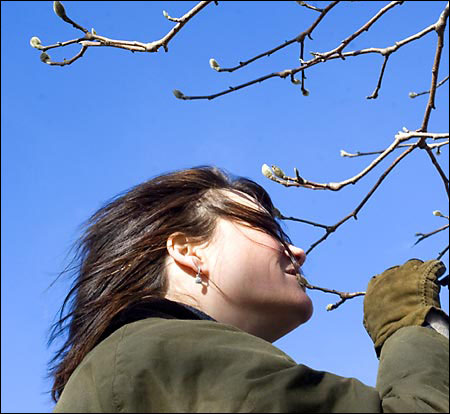Arnold Arboretum
A nursery for ideas as well as flora and fauna
• View multimedia presentation
When Gazette photographer Rose Lincoln first proposed shooting the Arnold Arboretum in wintertime, the entire Harvard News Office staff responded enthusiastically at the prospect of capturing the still and barren beauty of Harvard’s 265 woody acres during the cruelest and often prettiest months of the year. And though winter 2006 hardly cooperated with our preconceived ideas of bare-branched snow-swept oaks and elms (what with anomalies like pussy willows defiantly budding between the occasional cold snaps), we managed to learn something quite unexpected. Whether the winter is harsh or mild, the arboretum teems with life, botanical and otherwise.
Established in 1872, when the trustees of whaling merchant James Arnold’s will transferred a section of his Jamaica Plain estate to the fellows and president of Harvard College, the arboretum has since performed a unique function as Boston’s own living open-air museum. Thanks to the efforts of Charles Sprague Sargent, the enormous garden’s first director, the arboretum signed an imaginative lease arrangement (it expires in 2873) with the city of Boston, wherein the hefty plot officially became part of the city’s park system, specifically, the famed “Emerald Necklace.” Control of its collections – numbered today at nearly 13,100 trees and shrubs (including nursery holdings) representing 4,049 botanical and horticultural taxa – remained wisely with the institution’s staff. The result: a leading scientific research institution with an educational and recreational twist. Between the research (diseases of the hemlock, for example, and the shift in flowering time due to climate change), and the hardy joggers, dog walkers, and baby-strolling families, the arboretum grounds are seldom still.
And often, science and recreation work gracefully in tandem, as evidenced by the arboretum’s year-round selection of course offerings, lectures, and walks designed for school groups as well as adults. At a Feb. 4 “Winter Tree Observations” class, artist and naturalist Carol Govan led a lively course for 10 adults, whose reasons for attending ranged from a casual interest in trees to fulfilling landscaping certificate requirements. After some initial prepping and hands-on examination of leaves, twigs, and “tree cookies,” beautifully sliced cross sections of a tree trunk, Govan tackled the question: “What is a tree?”
With the basics out of the way (a tree, by the way, is a perennial plant with a single stem, a woody defined shape, measuring at least 20 feet tall), and loads of new knowledge about differing needle textures and varying bud and twig shapes fresh on the brain, the group – lucking out with a 40-degree February day – set out to explore and identify the arboretum’s vast offerings (each carefully labeled by a small copper plate), distinguishing the gymnosperms from the angiosperms. By the end of the four-and-a half-hour session, the students sounded less like casual tree admirers than burgeoning scientists.
Somewhere between 600 and 800 home gardeners and design professionals sign up to take nearly two dozen fee-based and free classes, workshops, and lectures throughout Boston’s chilliest months, making this time of year the arboretum staff’s busiest. Adding to the bustle are visitors exploring the arboretum’s archives and horticultural and photographic libraries, all housed in the historic Hunnewell Building, just past the main gate at 125 Arborway.

Keeping the grounds humming is a staff of 10 horticultural technologists, three arborists, and a superintendent and assistant superintendent. Using an array of heavy equipment and vehicles, the crew preps specimens for upcoming classes, monitors diseases and insects, and generally cares for the thousands of trees, shrubs, and vines on-site.
The arboretum has long placed a special emphasis on the conservation and maintenance of the woody species of North America and eastern Asia. It has sponsored numerous plant-collecting expeditions to Asia dating back to the early 20th century, and more recently, has received multiyear grants from the National Science Foundation to conduct expeditions in southwest China, peninsular Thailand, Irian Jaya (Indonesian New Guinea), and Papua New Guinea, some of which are now under way.
One result of all this activity is that the arboretum maintains one of the richest collections of Asian woody flora in the Western hemisphere, making this corner of Jamaica Plain a destination for researchers the world over. With support from the University and friends of the arboretum, staff will soon complete the digitization of the institution’s entire collection of archived Asian images. These will be made available through the University’s library system.
According to Robert E. Cook, director of the arboretum, the Harvard-allied institution is striving to keep up with cutting-edge developments in genetics and the study of the effects of global climate change on plant life. To fulfill these goals, the arboretum is in the planning stages of constructing a modern research laboratory at its Jamaica Plain location.
The arboretum is free and open to the public from sunrise to sunset every day of the year.




